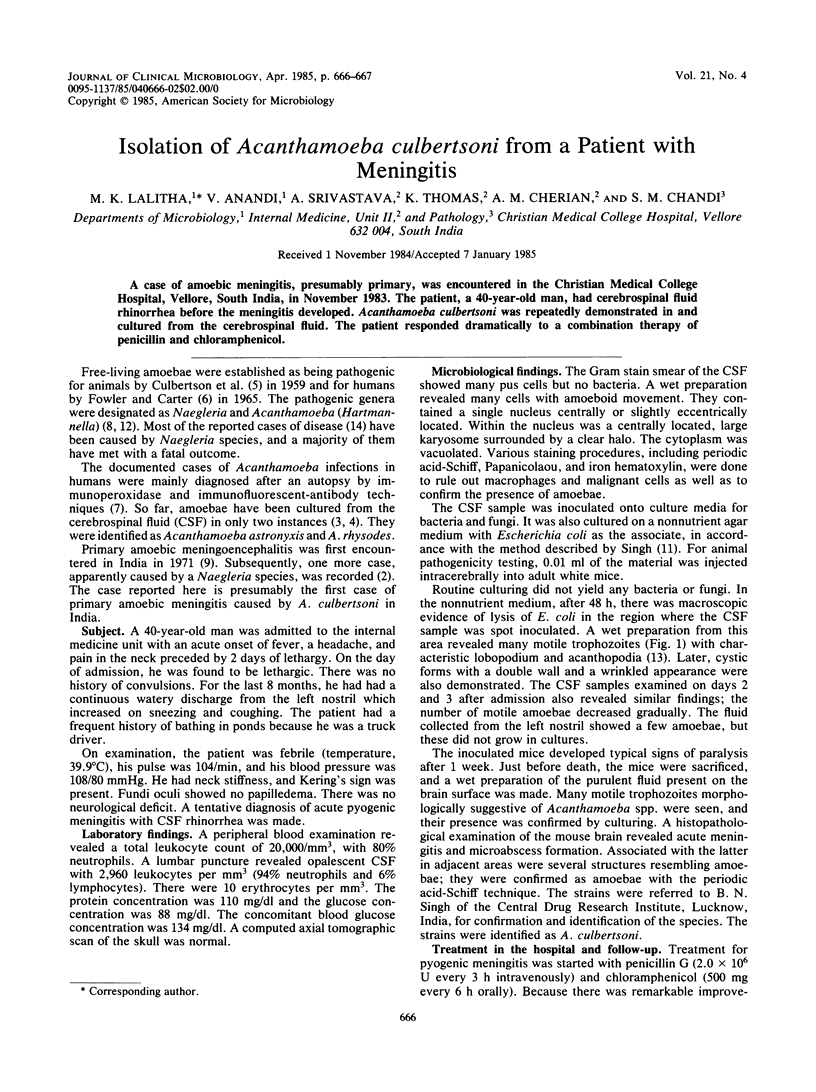Abstract
A case of amoebic meningitis, presumably primary, was encountered in the Christian Medical College Hospital, Vellore, South India, in November 1983. The patient, a 40-year-old man, had cerebrospinal fluid rhinorrhea before the meningitis developed. Acanthamoeba culbertsoni was repeatedly demonstrated in and cultured from the cerebrospinal fluid. The patient responded dramatically to a combination therapy of penicillin and chloramphenicol.
Full text
PDF

Images in this article
Selected References
These references are in PubMed. This may not be the complete list of references from this article.
- Apley J., Clarke S. K., Roome A. P., Sandry S. A., Saygi G., Silk B., Warhurst D. C. Primary amoebic meningoencephalitis in Britain. Br Med J. 1970 Mar 7;1(5696):596–599. doi: 10.1136/bmj.1.5696.596. [DOI] [PMC free article] [PubMed] [Google Scholar]
- Bedi H. K., Devapura J. C., Bomb B. S. Primary amoebic meningoencephalitis. J Indian Med Assoc. 1972 Jan 1;58(1):13–14. [PubMed] [Google Scholar]
- CULBERTSON C. G., SMITH J. W., COHEN H. K., MINNER J. R. Experimental infection of mice and monkeys by Acanthamoeba. Am J Pathol. 1959 Jan-Feb;35(1):185–197. [PMC free article] [PubMed] [Google Scholar]
- Callicott J. H., Jr, Nelson E. C., Jones M. M., dos Santos J. G., Utz J. P., Duma R. J., Morrison J. V., Jr Meningoencephalitis due to pathogenic free-living amoebae. Report of two cases. JAMA. 1968 Oct 14;206(3):579–582. [PubMed] [Google Scholar]
- Cleland P. G., Lawande R. V., Onyemelukwe G., Whittle H. C. Chronic amebic meningoencephalitis. Arch Neurol. 1982 Jan;39(1):56–57. doi: 10.1001/archneur.1982.00510130058016. [DOI] [PubMed] [Google Scholar]
- Fowler M., Carter R. F. Acute pyogenic meningitis probably due to Acanthamoeba sp.: a preliminary report. Br Med J. 1965 Sep 25;2(5464):740–742. doi: 10.1136/bmj.2.5464.734-a. [DOI] [PMC free article] [PubMed] [Google Scholar]
- Martínez A. J. Is Acanthamoeba encephalitis an opportunistic infection? Neurology. 1980 Jun;30(6):567–574. doi: 10.1212/wnl.30.6.567. [DOI] [PubMed] [Google Scholar]
- Page F. C. Re-definition of the genus Acanthamoeba with descriptions of three species. J Protozool. 1967 Nov;14(4):709–724. doi: 10.1111/j.1550-7408.1967.tb02066.x. [DOI] [PubMed] [Google Scholar]
- Pan N. R., Roy B. C., Ghosh T. N. Primary amoebic meningo-encephalitis in two Indian children. J Indian Med Assoc. 1971 Mar 1;56(5):134–137. [PubMed] [Google Scholar]
- Seidel J. S., Harmatz P., Visvesvara G. S., Cohen A., Edwards J., Turner J. Successful treatment of primary amebic meningoencephalitis. N Engl J Med. 1982 Feb 11;306(6):346–348. doi: 10.1056/NEJM198202113060607. [DOI] [PubMed] [Google Scholar]
- Stevens A. R., Shulman S. T., Lansen T. A., Cichon M. J., Willaert E. Primary amoebic meningoencephalitis: a report of two cases and antibiotic and immunologic studies. J Infect Dis. 1981 Feb;143(2):193–199. doi: 10.1093/infdis/143.2.193. [DOI] [PubMed] [Google Scholar]



